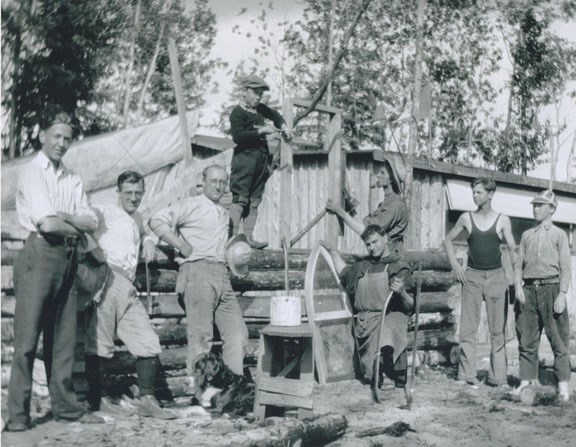Since its founding over 800 years ago, the Franciscan monastic order has focused on the lessons of its founder, St. Francis of Assisi - namely, live by the example of Jesus Christ. St. Francis went beyond the usual following of the philosophical examples of his God and began to live his life in a physical mimicry of Christ. He and his followers lived in poverty, owned only communal material possessions, treated animals as brothers, and shared an intense love for the environment.
In 1909, a small detachment of Franciscans reached Edmonton and founded St. Anthony's College and St. Francis of Assisi Parish to serve the population of northeastern Edmonton. In the early 1930s, it became apparent that the Edmonton Franciscans needed a haven outside the bustling city to relax and reacquaint themselves with the immaterial foundations of their order.
In early 1931, Achille Poitras and his sisters Clementine, Honorine and Marie made the Franciscans an offer they could not refuse. The Poitras family offered to the Franciscans of St. Francis of Assisi Parish a portion of their lakefront property on which to build a camp and mission for their members. Six years earlier, Achille, Clementine, Honorine and Marie had purchased 95 acres on the picturesque northwest shore of Moose Lake – in the Anshaw district - where the family farmed and operated a small sawmill.
The offer to the Franciscans was made on the condition that a weekly mass - that could be attended by all - be held at the new Mission. The Franciscans noted the many perks of the arrangement, including close proximity to the Poitras homestead to purchase necessities such as milk, cream, eggs and produce, enough space to house college residents who were unable to return home for the summer, and a beautiful natural environment to meditate on the teachings of their patron, and immediately they agreed.
In the spring of 1931, three Franciscan priests journeyed to the Bonnyville-area property, which they dubbed San Antonio in recognition of St. Anthony, for whom the Edmonton college was named, and erected a cabin large enough for 16 inhabitants. It originally functioned as a summer camp and retreat for members of the order and the students that they presided over. The camp, while first and foremost a place for spiritual exploration and growth, also taught campers the basics of outdoor life, fishing, and swimming.
In 1933, the church that the Franciscans promised the Poitras family was constructed. Christened Notre Dame de la Visitation, the rustic chapel was built with logs harvested from the land nearby, and had a spire that stood an impressive forty-five feet high with a wooden cross at its top. The elaborate stained glass-style windows of the chapel were yet another token of the Poitras family's generosity, as they were hand made by Clementine (a gifted folk artist) by gluing coloured tissue paper in patterns between two panes of glass.
Thirty families in the surrounding area became active parishioners at Notre Dame de la Visitation, with often 150 people arriving for Sunday's services. Father Joseph E. Lapointe, priest at Bonnyville's St. Louis Parish, was very supportive of the benefits of the Franciscan establishment as well, and contributed monetary support to the Franciscan mission.
In 1934, the Camp and Mission San Antonio became the victim of an unfortunate controversy. It became a concern to the urban Franciscans that San Antonio was not meeting the needs of the Friary or the Franciscan Council. Due to these concerns, the summer camp program was ceased and the facility was only used as a vacation destination for the Franciscan friars. Due to a shortage of priests and a lack of funding, the Camp and Mission San Antonio closed its doors in 1937, never to reopen again - much to the dismay of both Edmontonians and Bonnyvillians alike.
The Bonnyville & District Museum has on permanent display the original stained glass-style windows made by Clementine Poitras for the Franciscan chapel, Notre Dame de la Visitation – as well as other folk-art originals made by Clementine. These artifacts, as well as thousands of other objects at the museum help to tell the inspiring stories of the diverse history of the Bonnyville district.



